Shade Opens New Doors
When your landscape is basically all shaded, your whole game plan changes. Your dreams of the perfect landscape take some sharp turns and you’re left scratching your head wondering what to do next.
Good news abounds! There are solutions. There is hope. Here are suggestions I’ve accumulated after 40 years of living this same situation in the Sperry home landscape.
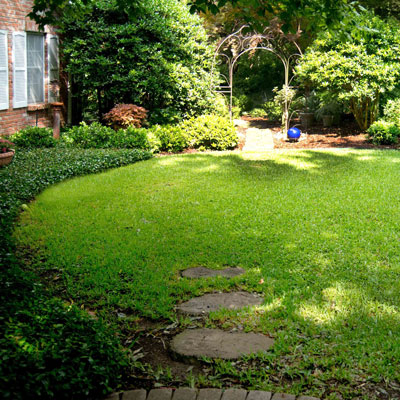
Before: As our pecan trees grew larger and larger, the shade they cast was getting progressively heavier. Eventually the St. Augustine finally played out. I knew something had to be done.
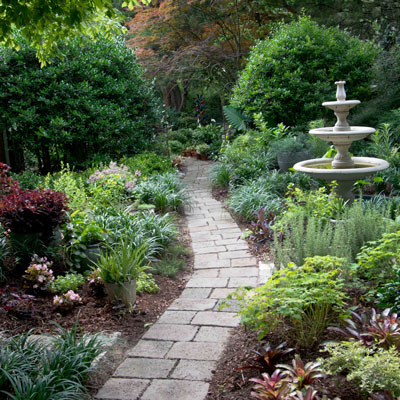
After: With the turfgrass gone I was freed to plant groundcovers (liriope, mondograss, purple wintercreeper and Asian jasmine) and shrubs (hollies, boxwood and others) that could cope with the shade.
1. When it’s too shady for turfgrass…
As trees grow larger and larger their shade is likely to choke out your lawngrass. Bermuda fades when it gets less than 8 hours of hot, direct summer sun. Zoysias need 7 to 8 hours. St. Augustine and fescues need 5 or 6. And then there’s bare ground. What can you do if you don’t have enough sunlight, but you long for something more than bare soil?

Photo: Our backyard is heavily shaded by towering pecan trees all summer. Mondograss has proved to be a fine substitute since turfgrass stands no chance of surviving.
• Mondograss, also known as monkeygrass and lilyturf, is the easiest of all the shade groundcovers. It’s been the go-to plant for the Sperry home landscape wherever I needed to replace failing St. Augustine. It grows to 6 to 8 inches deep, and it has a soft, grass-like appearance. It’s good on slopes, and it tolerates anything from heavy shade to half a day (morning) of direct sun. Its flowers are inconspicuous.
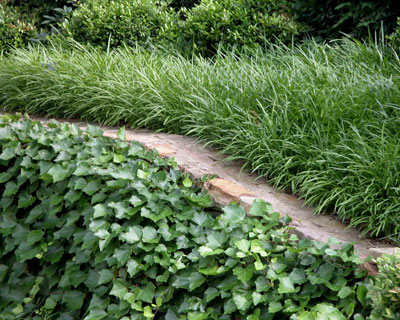
Photo: Liriope groundcover at top of slope holds the soil while English ivy provides nice contrast.
• Liriope is the big sister to mondograss. Liriope’s bolder blades are as wide as a pencil, and its summer flower spikes are lavender (a couple of varieties are white-flowering), followed by large purple-black berries. It makes a nice groundcover or edging if you want something a bit taller than mondograss.
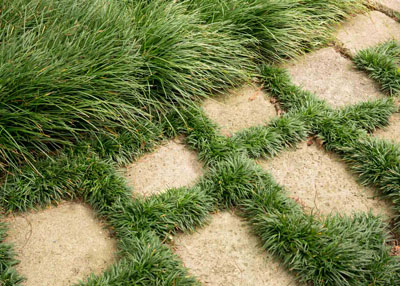
Photo: Regular and dwarf mondograss grow side-by-side in the Sperry home landscape. Metal edging keeps the regular mondo from invading into the walk.
• Dwarf mondograss goes the other direction. It stays less than 3 or 4 inches tall at maturity, making it probably the lowest groundcover we grow. But it’s also slow to spread, so it’s best used as a low border, in rock gardens and other smaller spaces where an extremely sculptured look is desired. It’s also sensitive to poorly drained soils. For all of those reasons, I prefer to use it in small plantings that are less strategic in my gardens.
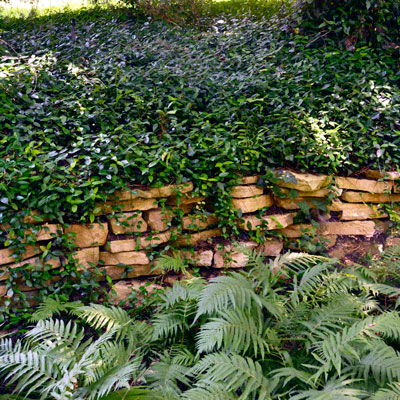
Photo: Asian jasmine and southern wood ferns thrive in heavily shaded portion of the Sperry landscape.
• Asian jasmine has long been the most popular full sun groundcover in Texas, and it’s well suited to shade as well. Do remember, however, that it has wiry stems, and leaves can get caught up in those stems, making blowing leaves in the fall a challenging task.
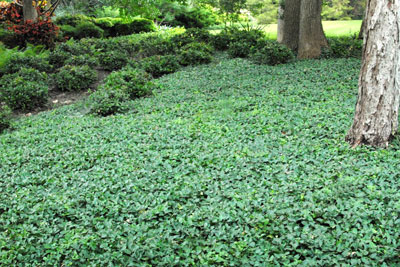
Photo: Purple wintercreeper euonymus has become my new go-to groundcover beneath oaks. It’s green in the summer and maroon all winter long.
• Purple wintercreeper euonymus has become one of the most popular full sun groundcovers for Texas, partly because we’re always looking for something different and partly because it’s more winter-hardy than Asian jasmine. It, too, produces runners, but leaves seem to be more easily removed from it than from Asian jasmine.
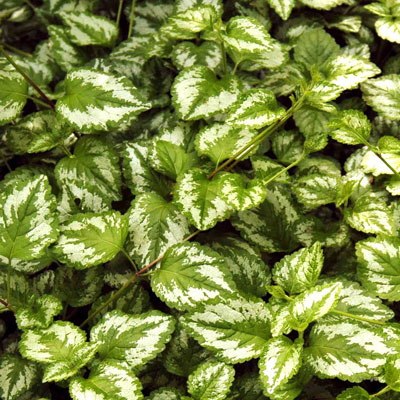
Photo: Lamium, or dead nettle, is a surprising and unusual delight as a shade-tolerant groundcover.
• Dead nettle (Lamium) is an unusual, but dependable option. Ajuga and English ivy are both candidates, but because of disease problems, each should be planted in limited areas.
• Wood ferns and aspidistras (cast iron plant) are two knee-high clumping plants that can be used as tall groundcovers. But that’s where any similarity between the two plants ends. Ferns bring the lightest, airiest texture to their surroundings. Aspidistra leaves are 18 inches long and 4 inches wide. They are ultimately bold-textured. In fact, the two plants are so diverse that they actually look good when planted alongside one another.
2. Shrubs for the shade…
Some shrubs must have full, or nearly full sunlight. As with lawngrasses, that translates into a requirement of 6 or 8 hours of direct sunlight daily. The list of sun-loving shrubs includes many of our most common evergreen types and most of our flowering shrubs.
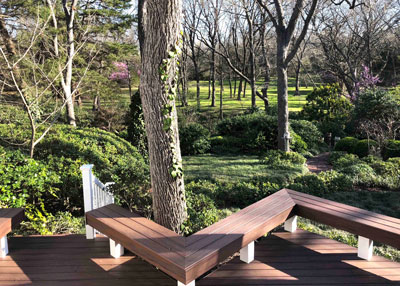
Photo: The Sperry backyard showcases shrubs, small trees and groundcovers that handle the shade without issue.
There are other shrubs that do famously in areas that have little or no direct sunlight. They’re the ones we need to consider when shade starts to dominate our landscaping lives.
Among the best are the many types of hollies. There is so much variation in the growth forms and looks of the hollies, that many (of us) have done entire landscapes using hollies almost exclusively.
The Sperry shade landscape includes (in order of increasing height at maturity) dwarf yaupon, dwarf Chinese, Carissa, dwarf Burford, Needlepoint (Willowleaf), Burford, Robin, Mary Nell, Oakland and Oakleaf, Weeping yaupon, Nellie R. Stevens, yaupon and Warren’s Red possumhaw hollies.
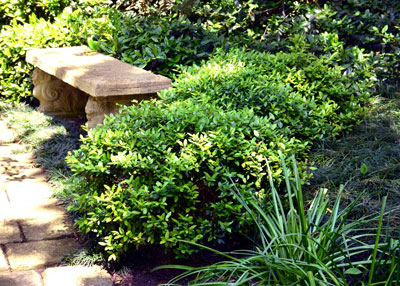
Dwarf yaupon holly
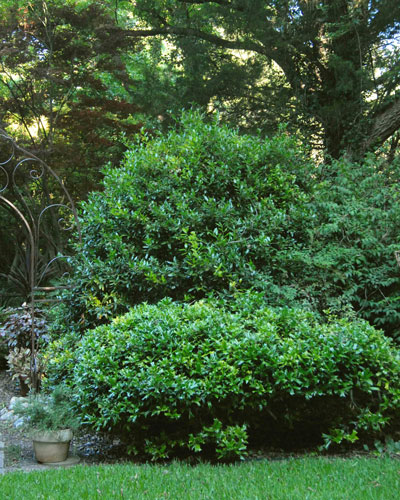
Willowleaf (Needlepoint) with dwarf Chinese holly in foreground.
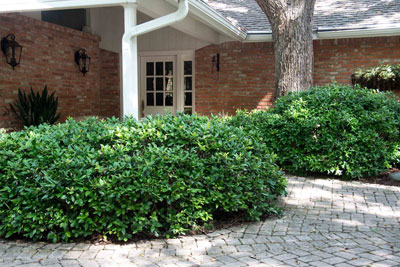
Carissa holly (l) and dwarf Chinese holly
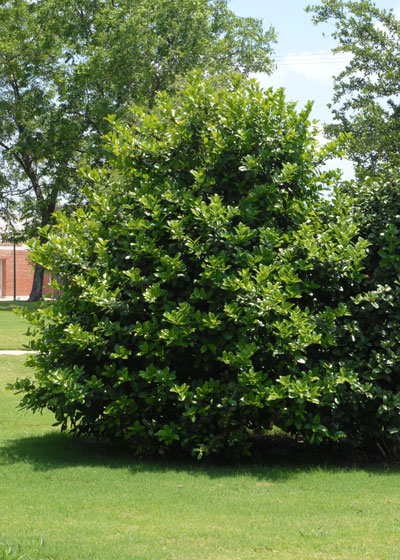
Mary Nell holly
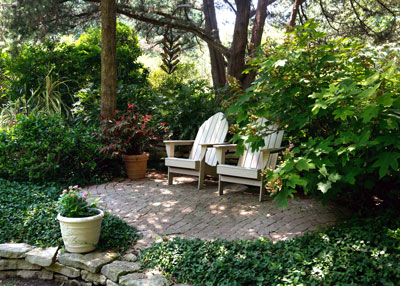
Patio in the Sperry landscape is surrounded by Oakleaf hydrangeas, hollies.
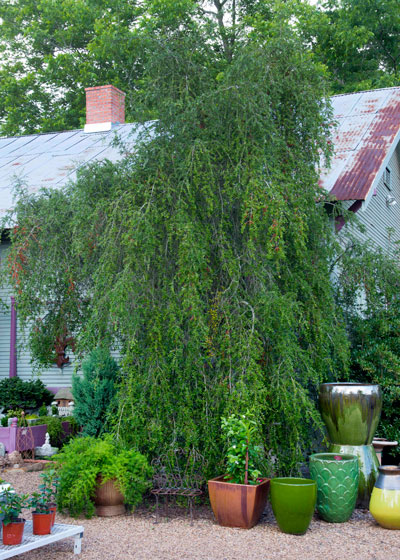
Weeping yaupon holly (Blue Moon Gardens, east of Edom in Chandler TX)

Nellie R. Stevens holly trained tree form.
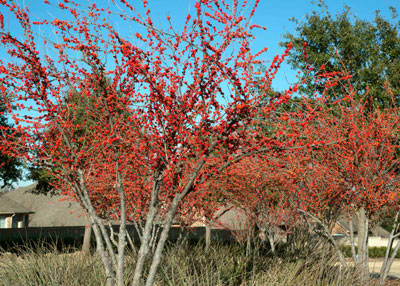
Warrens Red possumhaw holly
I actually have a few others like First Lady yaupon (a fruiting semi-dwarf form of yaupon), Dazzler and Berries Jubilee – and probably others – that are now virtually extinct in the nursery trade.
Other varieties of hollies such as Foster’s, Savannah and East Palatka, although commonly sold over much of the state, are not well suited to alkaline soils and require more careful planting unless you’re in East Texas.
Life in the shade beyond hollies…
Let’s assume, however, that you want something more than just hollies in your surroundings. Here are some other shrubs to consider.
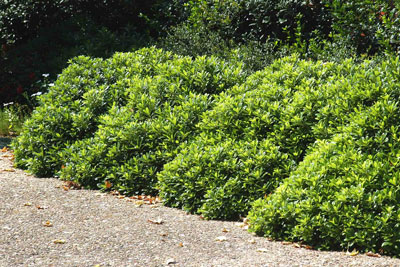
Wheeler’s dwarf pittosporum
Pittosporums do well in part shade but can be hurt by extreme cold in the northern half of the state, particularly near and north of the I-20 corridor.
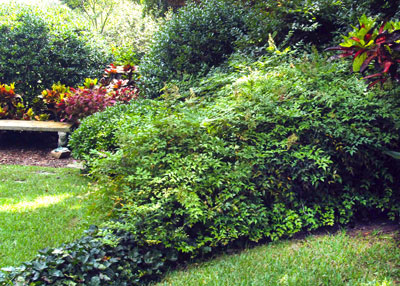
Compacta nandina
The several types of nandinas grow well in the shade, and if trees go bare in the winter to let the sun reach the nandinas’ foliage, you’re likely to see rich reds and maroons in their leaves. Nandinas bring a delightfully airy texture to their surroundings, a nice complement to the much bolder hollies.
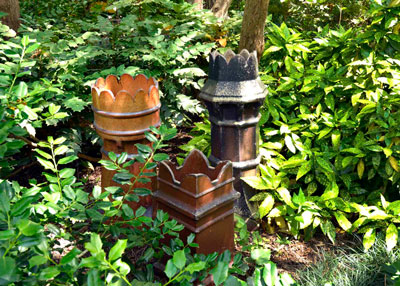
Aucubas surround antique English chimney pots
Aucubas must have full shade. There are speckled and banded brightly variegated types, but Gold Dust seems to be the most dependable overall. It is a great source of color in a dark, shaded corner.
Leatherleaf mahonias are related to nandinas, and they share the same dramatically upright growth habit. However, leatherleafs are extremely prickly. They’re also blue-green and dramatic. They produce bright yellow flowers in late winter which are quickly followed by grape-like clusters of sky blue fruit, favorites of birds. This plant grows to 4 to 5 feet tall and 4 feet wide, and it’s fabulous in shade or early morning sun.
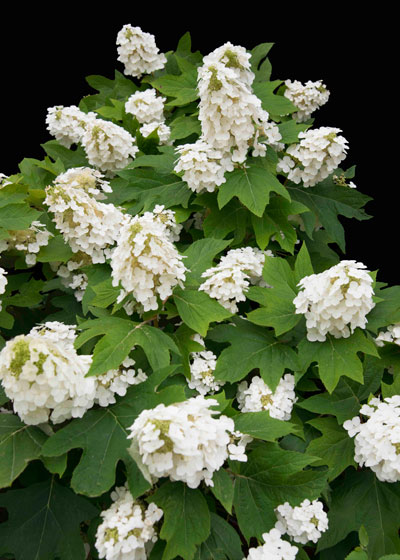
Oakleaf hydrangea
Oakleaf hydrangeas are large and bold shrubs that are noted for their giant white floral heads in late spring and their rich red fall color each November. They do well in any moist, shady location. They’re easier to grow in challenging sites than their sister mophead hydrangeas, the pink or blue florist-style selections that are commonly found in East Texas.
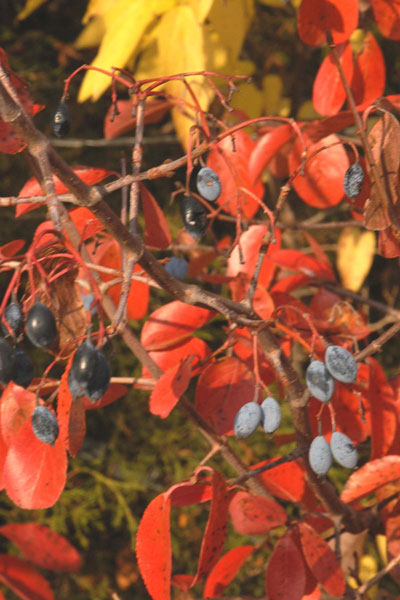
Rusty blackhaw viburnum
Rusty blackhaw viburnum, sweet viburnum (another winter-vulnerable plant) and eastern snowball viburnumss add to the list of shrubs that perform best in the shade. Viburnums are under-planted in Texas, and these three deserve your consideration.
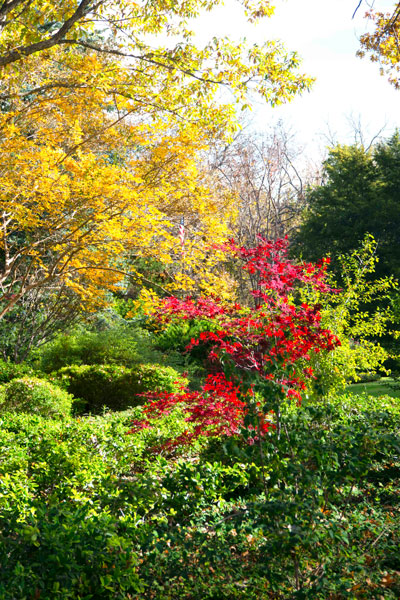
Japanese maple
Japanese maples are actually trees, of course, but some of the varieties double as shrubby plants in our landscapes. They must have shade in most of Texas, and they’re best suited to East and Northeast Texas. Both green- and purple-leafed types are available, but the critical thing to check before you buy one is its mature size. The different varieties will range from 5 or 6 feet to 20 feet tall and taller at maturity. Buy and plant accordingly.
3. When You Want Color
When your shade trees grow as you hope they can leave you with a blank slate for landscaping. You find that all the shrubs and turfgrass have faded away. You’ve replanted with shade-tolerant species, but now you’re wondering how to create a little visual interest. How can you bring color into the shadows? What are your choices?
I’ve faced those same questions in the decades that we’ve lived beneath pecan trees. They were mid-sized at first, but now they’re veritable giants, and turfgrass is a distant memory. I’ve given you options, and now it’s time for the finishing touches.
Ways I’ve coped with our shade…
Please let me say first that our landscape, while attractive, isn’t any nicer than hundreds of others around our part of Texas. But it’s the one with which I’m most familiar, so it’s the one from which I will teach.
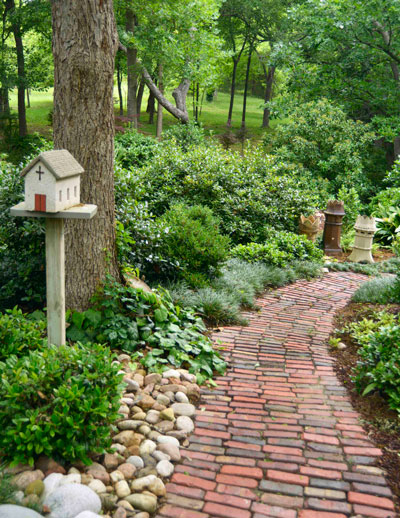
Garden art river rock and antique brick pavers draw attention.
I knew I wouldn’t be able to get many flowering plants to thrive in all the shade. I scoured antique malls and salvage yards, and I was lucky enough to find a pile of old street pavers dating back to the late 1890s and early 1900s. I bought enough to run a sweeping path through our garden, so the need for turf as a walking surface was replaced.
Next, I wanted a few strong focal points in my garden, so I built a wood church from really old salvaged lumber. Unfortunately, my church and its old lumber finally decayed, and it’s made its final trip to another salvage pile. But, I found a more modern replacement, and it became the star of its part of our gardens. It’s made of some type of concrete material, so it probably needs to go into the will.
Those ceramic “things” you see at the other end of the walk are actually antique English chimney pots. They topped rather ordinary chimneys on the South Coast of England before those tall houses were razed and the pots shipped to my yard (and elsewhere).
For a little variety, I’ve assembled river rock along a couple of sections of the walk. It brings a nice light tone to its surroundings, and it holds the soil well. It also is extremely bold-textured, and that’s a nice contrast to all the fine-bladed mondograss I use as my groundcover.

Ceramic globes provide a spot of color in a sea of green.
Finally, just for whimsy and a little permanent color, I’ve put several ceramic globes out in the mondograss. I’m a bit obsessive about these things. I actually have six or seven more in other parts of our gardens.
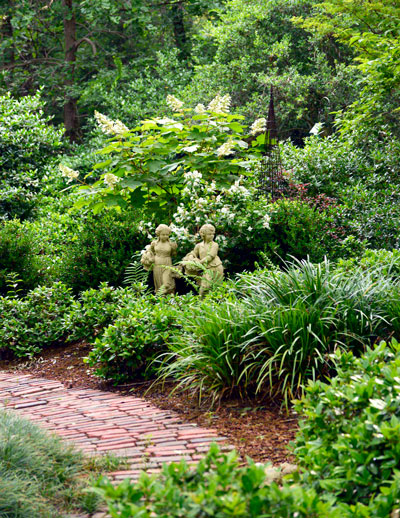
Oakleaf hydrangea and mock orange bloom while statues create focal point.
Flowering shrubs…
In addition to the evergreen shrubs listed, I also have a couple of flowering shrubs in our backyard. Mock orange (Philadelphus sp.) has small, semi-double white blooms in early May, and oakleaf hydrangeas bear their giant flower heads about the same time. White shows well in a shady garden, and each of these seems to be prospering.
Flowering vines…
If I wanted to grow spring-flowering vines in a part of my shade garden, I’d turn to Carolina jessamine, sweet autumn clematis, evergreen clematis or crossvine.
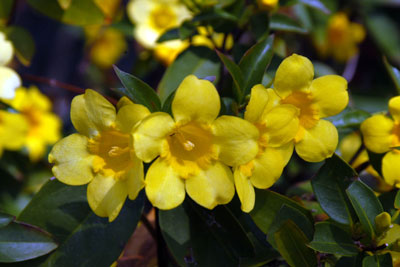
Carolina jessamine
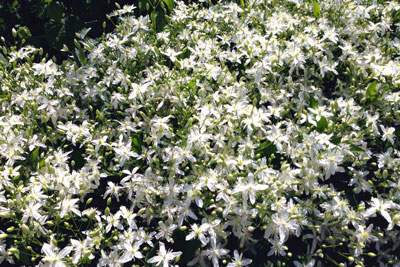
Sweet autumn clematis
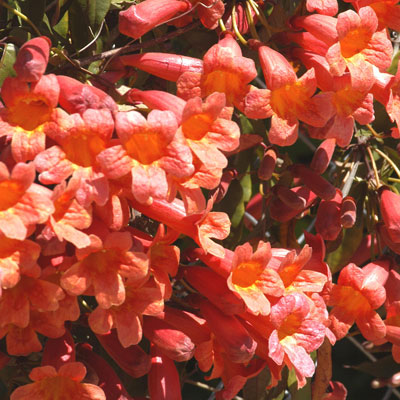
Crossvine
Annuals…
For annuals I’d choose from coleus, caladiums, elephant ears, begonias, impatiens, nicotiana (flowering tobacco) and pentas (partial sun).

Red Dragon Wing begonias
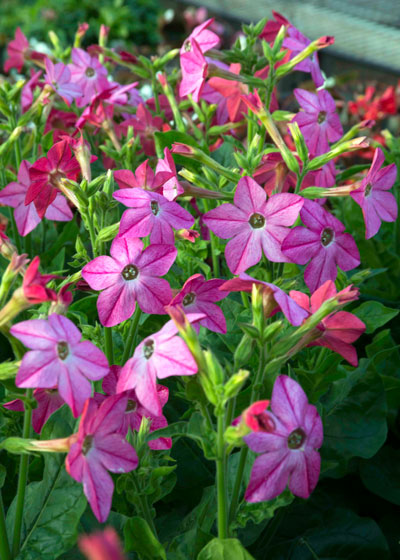
Perfume Bright Rose Nicotiana
Perennials…
For perennials I’d select from ajuga, oxalis, summer phlox, hostas, hellebores, Solomon’s Seal, ferns, Texas Gold columbines and various bulbs such as jonquils, spider lilies, naked lady lilies, oxblood lilies and fall crocus.
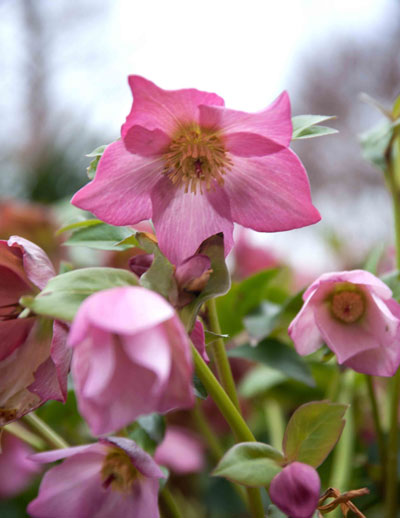
Rose hellebore
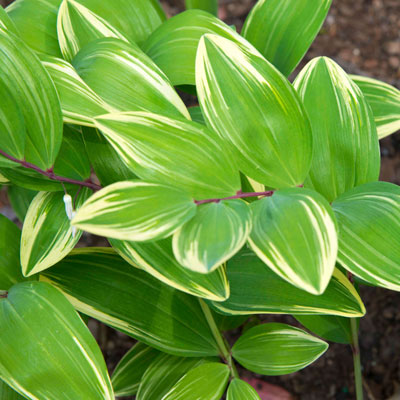
Solomon’s Seal
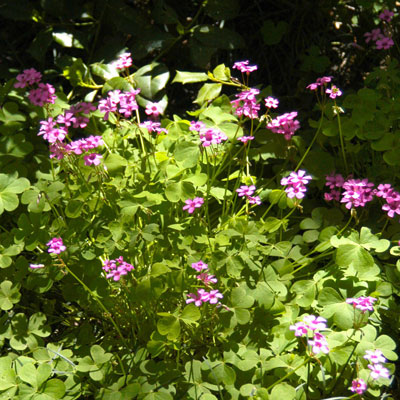
Oxalis
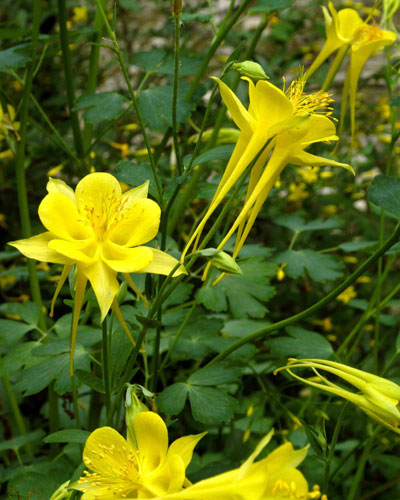
Columbine Texas Gold
Tropical interest…
I get a lot of bang for my bucks with tropical plants, not only for their colorful foliage but also for their fascinating textures. That list includes crotons, Xanadu philodendron, aglaonemas, ferns, sansevierias, pony tail, peace lilies and dracaenas.
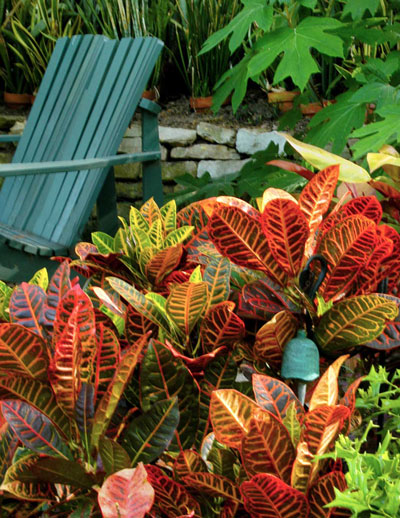
Crotons color up the Sperry landscape with minimal sun.

Bromeliads sansevierias add dramatic color but need shade after mid morning.
